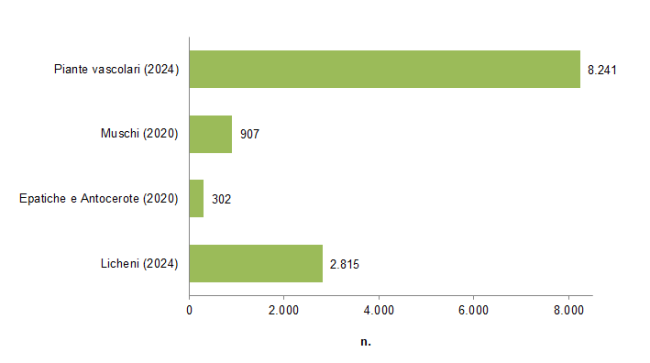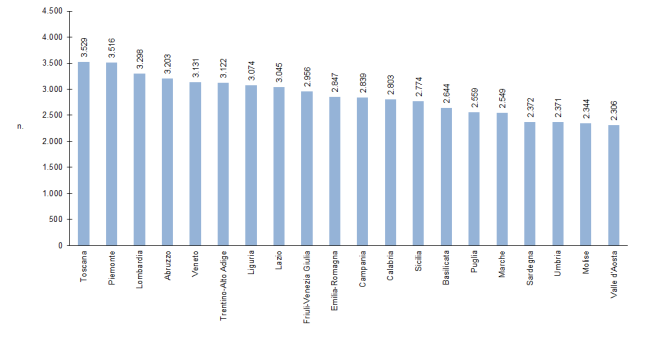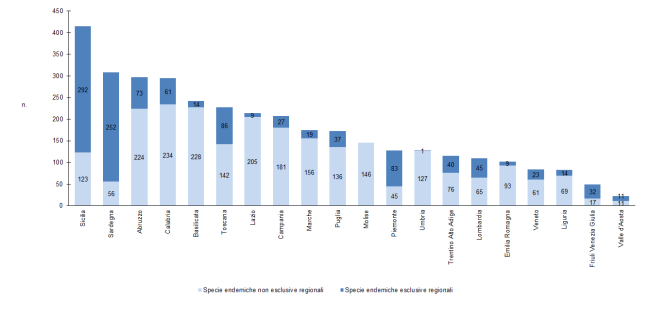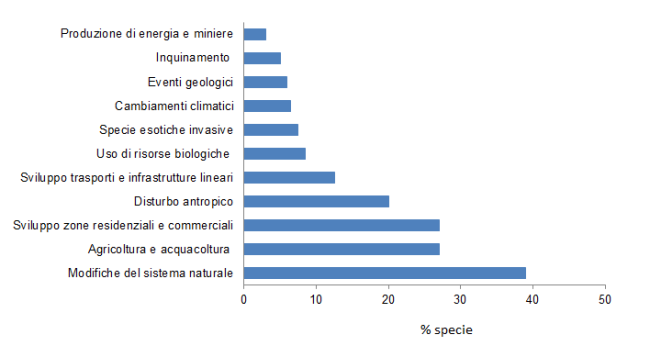Panel 1
Stefania Ercole, Valeria Giacanelli
Italy hosts a remarkable floristic heritage, both in terms of species and subspecies richness (2,815 lichens, 1,209 bryophytes, and 8,241 native vascular entities) and biogeographical value. Of the 8,241 Italian vascular plant,1,702 species (equal to 20.65%) are endemic, meaning they exist exclusively in the country. Among these, 1,128 species are regionally endemic, with their range restricted to a single Italian region (data updated to April 2024).
The indicator also highlights the IUCN risk status of 2,430 vascular plant entities (representing 29.5% of Italy’s vascular flora), identifying the main threats affecting them. Unfortunately, the overall conservation status cannot be considered satisfactory: 2.2% (54 species) of the 2,430 evaluated entities are extinct or likely extinct; 24.3% (590 species) are at risk of extinction.
Human-induced pressures related to land-use changes represent a major driver of plant species extinction risk. The Red List of vascular flora identifies the most critical pressures affecting species: Modification of natural systems (39% of the 2,430 assessed taxa are subject to this pressure);
Agricultural development (27%); Residential development (27%); Direct human disturbance in natural environments (20%).
The indicator provides data on floristic richness at national and regional levels (vascular and non-vascular plants). The indicator also includes data on rate of endemism (vascular plants), which are particularly relevant for conservation efforts (national responsibility)and the IUCN risk status for a relevant set of plant species assessed in the Italian Red Lists (2,430 vascular plants and 772 non-vascular plants).
To describe Italian floristic richness (on both a national and regional scale) and to present the extinction risk level.
At the international level the key legal references are:
-the Bern Convention (September 19, 1979) aims to ensure the conservation of wild flora and fauna and their natural habitats (Article 1) and to prioritizes species that are endangered, vulnerable, or endemic (Article 3);
-the Habitats Directive (92/43/EEC): aims to safeguard biodiversity by preserving natural habitats and wild flora and fauna within EU Member States (Article 2).
At European level, the EU Biodiversity Strategy for 2030 (Brussels, 20.5.2020, COM (2020) 380 final) sets new conservation targets, requiring member states to prevent further deterioration of protected habitats and species by 2030, and to ensure that at least 30% of species and habitats currently in unsatisfactory conservation status show a clear positive trend.
Italy does not have a comprehensive national protection law for flora, though regional regulations have established lists of protected species (Alonzi et al., 2007).
Panel 2
Bartolucci F., Peruzzi L., Galasso G., et alii, 2018 - An updated checklist of the vascular flora native to Italy. Plant Biosystems, 152 (2).
Bartolucci F., Peruzzi L., Galasso G., et alii, 2024 - A second update to the checklist of the vascular flora native to Italy, Plant Biosystems, 158 (2).
Bilz M., Kell S.P., Maxted N., Lansdown R.V., 2011 - European Red List of Vascular Plants. Publications Office of the European Union, Luxembourg.
Conti F., Abbate G., Alessandrini A., Blasi C. (eds.) 2005 - An annotated checklist of the Italian vascular flora. Roma, Palombi Editori.
Conti F., Manzi A., Pedrotti F., 1992 - Libro Rosso delle Piante d'Italia. MATTM, WWF Italia.
Conti F., Manzi A., Pedrotti F., 1997 - Liste Rosse Regionali delle Piante d'Italia. WWF Italia, SBI, Univ. Camerino.
Conti et alii, 2007 - Integrazioni alla Checklist della flora vascolare italiana. Natura Vicentina, 10 (2006): 5-74, (Vicenza).
EAA, European Environment Agency, 2015 - State of nature in the EU - Results from reporting under the nature directives 2007–2012. EEA Technical report No 2/2015.
ISPRA - Ercole S., Giacanelli V., 2014 - Flora. In: Genovesi P., Angelini P., Bianchi E., Dupré E., Ercole,S., Giacanelli V., Ronchi F., Stoch F. (eds) - Specie e habitat di interesse comunitario in Italia: distribuzione, stato di conservazione e trend. Serie Rapporti 194/2014.
IUCN, 2012a - IUCN Red List categories and criteria: version 3.1. 2nd ed., Gland, Switzerland and Cambridge (UK): IUCN Species Survival Commission, iv+32 pp.
IUCN, 2012b. Unified Classification of Direct Threats: Version 3.2.
IUCN, 2013 a - Guidelines for using the IUCN Red List Categories and Criteria. Version 10. Prepared by the Standards and Petitions Subcommittee.
IUCN, 2013 b - Italy’s biodiversity at risk. A call for action. IUCN Brussels, Belgium.
Orsenigo S., Montagnani C. et alii, 2018 - Red Listing plants under full national responsibility: extinction risks and threats in the vascular flora endemic to Italy. Biological Conservation 224: 213-222.
Peruzzi L., Conti F. & Bartolucci F., 2014 - An inventory of vascular plants endemic to Italy. Phytotaxa 168 (1): 1-75
Pignatti S., 1982 - Flora d'Italia. 3 voll. Edagricole. Bologna.
Rossi G. et alii, 2016 - Is legal protection sufficient to ensure plant conservation? The Italian Red List of policy species as a case study. Oryx 50(03): 431-436.
Scoppola A., Spampinato G., 2005 - Atlante delle specie a rischio di estinzione (CD-ROM). MATTM, DPN, SBI, Univ. Tuscia, Univ. La Sapienza.
http://dryades.units.it/briofite/index.php
http://dryades.units.it/floritaly/
http://dryades.units.it/italic/index.php
http://www.iucn.it/liste-rosse-italiane.php
The main limitations concern the difficulty in obtaining homogeneous data over time and across gruops of species, as well as the unpredictability of data updates. The only exception is for vascular plants, for which an annual summary report has been published since 2021. This report provides updated richness data, which are made available on the Flora of Italy portal and are updated twice a year.
Implement a national monitoring network to increase knowledge about our flora and be able to periodically update IUCN assessments.
Data quality assessment
Aleffi M., Tacchi R., Poponessi S., 2020 - New Checklist of the Bryophytes of Italy. Cryptogamie, Bryologie 41 (13): 147-195. https://doi.org/10.5252/cryptogamie-bryologie2020v41a13.
Bartolucci F., Peruzzi L., Galasso G., et alii, 2024 - A second update to the checklist of the vascular flora native to Italy, Plant Biosystems, 158 (2). DOI: 10.1080/11263504.2024.2320126.
Cortini Pedrotti, 1992 - Check-list of the Mosses of Italy. Fl. Medit., 2.
Nimis P.L., Martellos S., 2024 - ITALIC - The Information System on Italian Lichens. Version 7.0. University of Trieste, Dept. of Biology, (http://dryades.units.it/italic), (ultima consult. 24 luglio 2024)
Nimis, 1992 - Lista rossa dei licheni d'Italia. In: Conti, Manzi, Pedrotti, 1992. Libro Rosso delle Piante d'Italia. MATTM
Orsenigo S., Fenu G., Gargano D. et alii, 2020 - Red list of threatened vascular plants in Italy. Plant Biosystems 155 (2): 310-335. https://doi.org/10.1080/11263504.2020.1739165
Portale della Flora d’Italia 2024.2 - http:/dryades.units.it/floritaly (ultima consult. luglio 2024)
Consultation of bibliographic sources and online databases (see data sources and description of processing methodology).
National, Regional (20/20)
1992, 2013, 2014, 2015, 2017, 2018, 2020, 2022, 2024 (dates of reference sources)
Indicator assessment
The indicator is based on data from multiple sources (checklists and Red Lists) with variable update years. In the analyses plant species are divided into the following taxonomic groups: Lichens, Bryophytes (Liverworts and Hornworts, Mosses) and Vascular Plants.
The indicator presents data on the numerical composition of Italian flora, derived from the latest publications for different taxonomic groups (Aleffi et al., 2020; Nimis & Martellos, 2024; Bartolucci et al., 2024). For each group, the total number of taxa (species and subspecies) is provided.
For vascular flora, data are presented at both the national and regional levels, also considering the rate of endemism. For each administrative region, the following are reported:
-Total number of taxa (species + subspecies) (Bartolucci et al., 2024), including the following categories: present, doubtful, unconfirmed, extinct or probably extinct (including cryptogenic entities, whose origin is unknown).
-Number of Italian endemic taxa and regionally exclusive endemics. The endemism data refer to: taxa restricted to Italian territory and species found in both Italy and in Corsica and Malta (Bartolucci et al., 2024).
The indicator also presents data on the Red List status i.e. the composition of endangered flora, for non-vascular plants (Cortini Pedrotti & Aleffi, 1992; Nimis, 1992) and vascular plants (Orsenigo et al., 2020).
For bryophytes (liverworts, mosses) and lichens, the level of threat is assessed following the methodology of Cortini Pedrotti & Aleffi (1992) and Nimis (1992), using four categories: EX (Extinct),EN (Endangered),VU (Vulnerable), R (Rare) – a category added for species recorded in fewer than five locations over the past 50 years.
For vascular plants (Orsenigo et al., 2020), the classification follows the latest IUCN guidelines (IUCN, 2012a) and uses the Version 3.1 categories: EX (Extinct),EW (Extinct in the Wild), CR(PE) (Critically Endangered – Possibly Extinct), CR (Critically Endangered), EN (Endangered), VU (Vulnerable), NT (Near Threatened), LC (Least Concern), DD (Data Deficient), NE (Not Evaluated). Additionally, for regional assessments, the RE (Regionally Extinct) category is included.
The pressure data (Orsenigo et al., 2020) follow the IUCN Version 3.2 classification system (IUCN, 2012b).
The IUCN conservation status categories used in the different Red Lists depend on the publication date and the IUCN criteria in effect at the time.
The conservation status of Italian flora must be considered poor, given the percentage of species at risk of extinction and those already extinct. Of the 2,430 vascular taxa assessed in the Italian Red List:
24.3% (590 species) are at risk of extinction (VU + EN + CR)
2.2% (54 species) are extinct or probably extinct (Figure 4)
The trend is negative, as the current trend does not move in the desired direction: the percentage of plant species at risk is increasing in Italy, and the extinction data are alarming.
Anthropogenic pressures related to land-use changes continue to impact Italian territory and currently represent one of the major drivers of plant species extinction risk.
The latest Red List of vascular flora highlights that the most significant pressures are:
Modifications to natural systems (39% of the 2,430 taxa assessed are subject to this pressure)
Agricultural development (27%)
Residential development (27%)
Direct human disturbance of natural environments (20%) (Figure 5)
Data
Table 1: Number of entities (species + subspecies) of total vascular plants on Italian territory, in each Region (agg. Apr 2024)
ISPRA elaboration on data taken from: Bartolucci et al., 2024 - Second update of the Italian native vascular flora checklist. Plant Biosystems, 158(2)
The total number of entities includes the following categories: present, doubtful, unconfirmed, extinct or probably extinct (including cryptogenic)
Table 2: Italian endemic vascular plants. Total number and number of exclusives of each regional territory (agg. 2024)
ISPRA elaboration on data from Bartolucci et al., 2024 - A second update to the checklist of the vascular flora native to Italy. Plant Biosystems, 158(2)
Portal of the Flora of Italy 2024.2. http:/dryades.units.it/floritaly (last consult. July 2024)
Table 3: IUCN threat level of Italian flora (adj.: lichens 1992; bryophytes 1992, vascular plants 2020)
ISPRA processing of data from scientific literature (see data source)
Extinct species (EX extinct), extinct in the wild (EW extinct in the wild), critically endangered (CR critically endangered), probably extinct CR(PE), endangered (EN endangered), vulnerable (VU vulnerable), near threatened (NT near threatened), low risk (LC least concern), data deficient (DD data deficient), not evaluated (NE not evaluated), rare (R)
The three numbers for cat CR, EN and VU for vascular plants were deduced from the percentages because the source does not provide the numbers, only the percentages.
Figure 1: Number of plant entities (species + subspecies) reported by national checklists, divided by systematic group
ISPRA elaborations on data taken from Aleffi, Tacchi, Poponessi, 2020 - New Checklist of the Bryophytes of Italy. Cryptogamie, Bryologie 41(13).
Nimis & Martellos, 2024 - ITALIC - The Information System on Italian Lichens. Version 7.0. https://dryades.units.it/italic, accessed on 25/07/2024. Bartolucci et al., 2024 - A second update to the checklist of the vascular flora native to Italy. Plant Biosystems, 158(2)
The update dates for each group are given in parentheses (corresponding to the date of publication of the source)
Figure 2: Number of vascular flora entities (species + subspecies) in each Italian region (agg. Apr. 2024)
ISPRA elaboration on data taken from: Bartolucci et al., 2024 - Second update of the Italian native vascular flora checklist. Plant Biosystems, 158(2)
The total number of entities includes the following categories: present, doubtful, unconfirmed, extinct or probably extinct (including cryptogenic)
Figure 3: Number of Italian endemic vascular species found in each region, divided into exclusive and non-exclusive of the regional territory (agg. 2024)
ISPRA elaboration on data taken from: Bartolucci et al., 2024 - A second update to the checklist of the vascular flora native to Italy. Plant Biosystems, 158(2)
Portale della Flora d’Italia 2024.2. http:/dryades.units.it/floritaly (ultima consult. luglio 2024)
Figure 4: Threat level of the Italian vascular flora: percentage distribution in IUCN categories of extinction risk of the 2,430 vascular plants assessed (agg. 2020)
Orsenigo et al. 2020. Red list of threatened vascular plants in Italy. Plant Biosystems
EX: regionally extinct, EW: extinct in the wild, CR(PE): probably extinct species, CR: critically endangered, EN: endangered, VU: vulnerable, NT: near threatened, LC: least concern, DD: data deficient.





The Italian flora is among the richest in Europe, with 3,913 non-vascular plant species, including 302 Liverworts and Hornworts, 907 Mosses (Aleffi et al., 2020), and 2,815 Lichens (Nimis and Martellos, 2024), as well as 8,241 vascular plant species (Bartolucci et al., 2024) (Figure 1).
It is also worth noting the continuous updates to knowledge due to taxonomic revisions and the increasingly thorough exploration of the territory. These updates are available for the vascular flora on the Portal of Flora of Italy (http://dryades.units.it/floritaly/), and for lichens on the ITALIC system (http://dryades.units.it/italic).
At the regional level, in 8 out of 20 regions, the number of vascular plant species exceeds 3,000 species and subspecies (Figure 2, Table 1).
The data in Table 1, updated in April 2024, not only provide an indication of floristic richness but also the vulnerability to significant biodiversity loss. The last two columns show the disappearance of many species from regional territories in recent decades (species no longer found and species extinct or probably extinct).
The endemic vascular flora of Italy consists of 1,702 species (20.65% of the total vascular flora), including species and subspecies that are exclusive to Italy or present in Italy, Corsica and Malta. Of these, 66.3% are also exclusive to specific regions (Bartolucci et al., 2024) (Table 2). The number of endemic vascular species present in each region (divided into endemic and exclusive endemic species) allows us to appreciate the biogeographical importance of regional floras, with notable examples (Figure 3 and Table 2) including Sicily (415 endemic species, of which 292 are exclusive to the region), Sardinia (308 endemic species, of which 252 are exclusive), Abruzzo (297 endemic species, of which 73 are exclusive), and Calabria (295 endemic species, of which 61 are exclusive). Other regions of peninsular Italy (Basilicata, Tuscany, Lazio, Campania, Marche, Puglia) also have significant endemic components. Alpine regions are not highlighted in these analyses, despite their phytogeographical relevance, as plants distributed in the Alps that are also found in neighboring countries are not considered endemic.
The IUCN assessment of the risk of extinction for Italian flora has been carried out for 772 lichens and bryophytes (out of a total of 3,913 known species) and for 2,430 vascular plants (out of a total of 8,249 known species) (Table 3; Figure 4).
The Red Lists of non-vascular plants date back to the 1990s (Cortini Pedrotti and Aleffi, 1992; Nimis, 1992), using methodologies and criteria that have since been replaced by new standards (IUCN, 2012a), which are now applied in the most recent Red Lists (Orsenigo et al., 2018, 2020). In the last decade, red-listing activities have focused on specific sets of Italian plant species of conservation interest, particularly: policy species, endemic Italian species (according to Peruzzi et al., 2014), species typical of threatened habitats (such as coastal and wetland habitats) that have experienced documented declines in the last 30 years, and species evaluated as EX, EW, or CR in previous Red Lists (Conti et al., 1992, 1997).
To date, 2,430 vascular plant species have been evaluated (Orsenigo et al., 2020), representing 29.5% of Italy's vascular flora. The results of these evaluations are worring (Figure 4): 54 species (2.2% of the 2,430 species evaluated) are extinct or probably extinct (EX+EW+CR(PE)), 590 species (24.3%) are endangered and at risk of extinction (VU+EN+CR), while 404 species (16.6%) could not be evaluated due to lack of data (Orsenigo et al., 2020).
Major threats include: agricultural practices, land consumption, construction of residential and transportation infrastructures, as well as disturbance and fragmentation of ecosystems. The recent Red List of vascular plants (Orsenigo et al., 2020) shows that the most common pressures threatening Italian plant species are changes to natural systems (39% of the 2,430 taxa evaluated are threatened by this pressure), agricultural development (27%), residential development (27%), and direct human disturbance of natural environments (20%) (Figure 5). Multiple pressures from human activities often act simultaneously (Orsenigo et al., 2020).Only 20% of species (484) are not threatened by any kind of pressure, but these are mostly species living in high altitude mountain areas. Species living in coastal environments and lowland areas show the greatest risks. Currently, climate change and invasive alien species do not seem to be among the main pressures (Figure 5), but this may be due to the current lack of methodologies for assessing and quantifying these impacts.